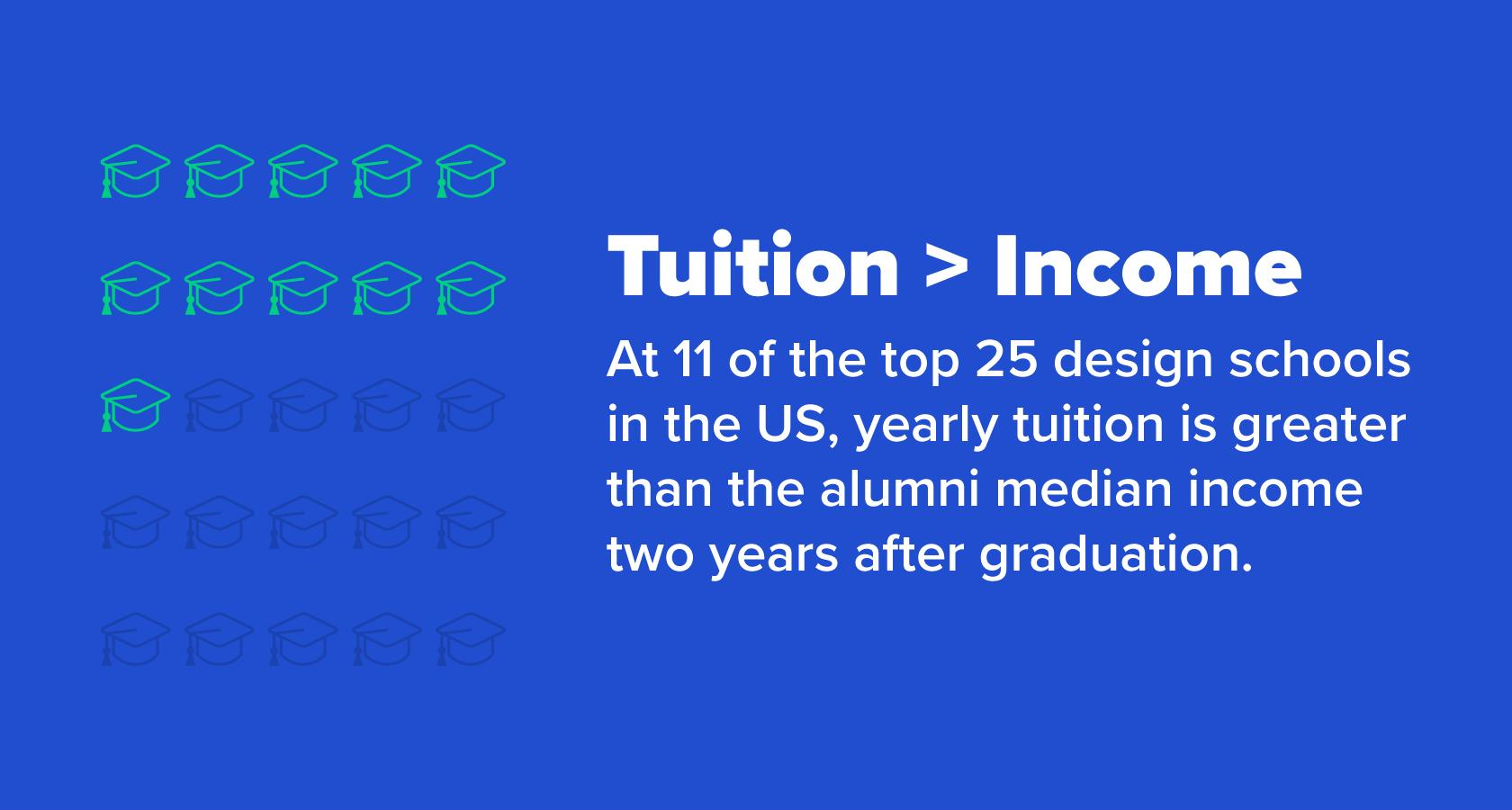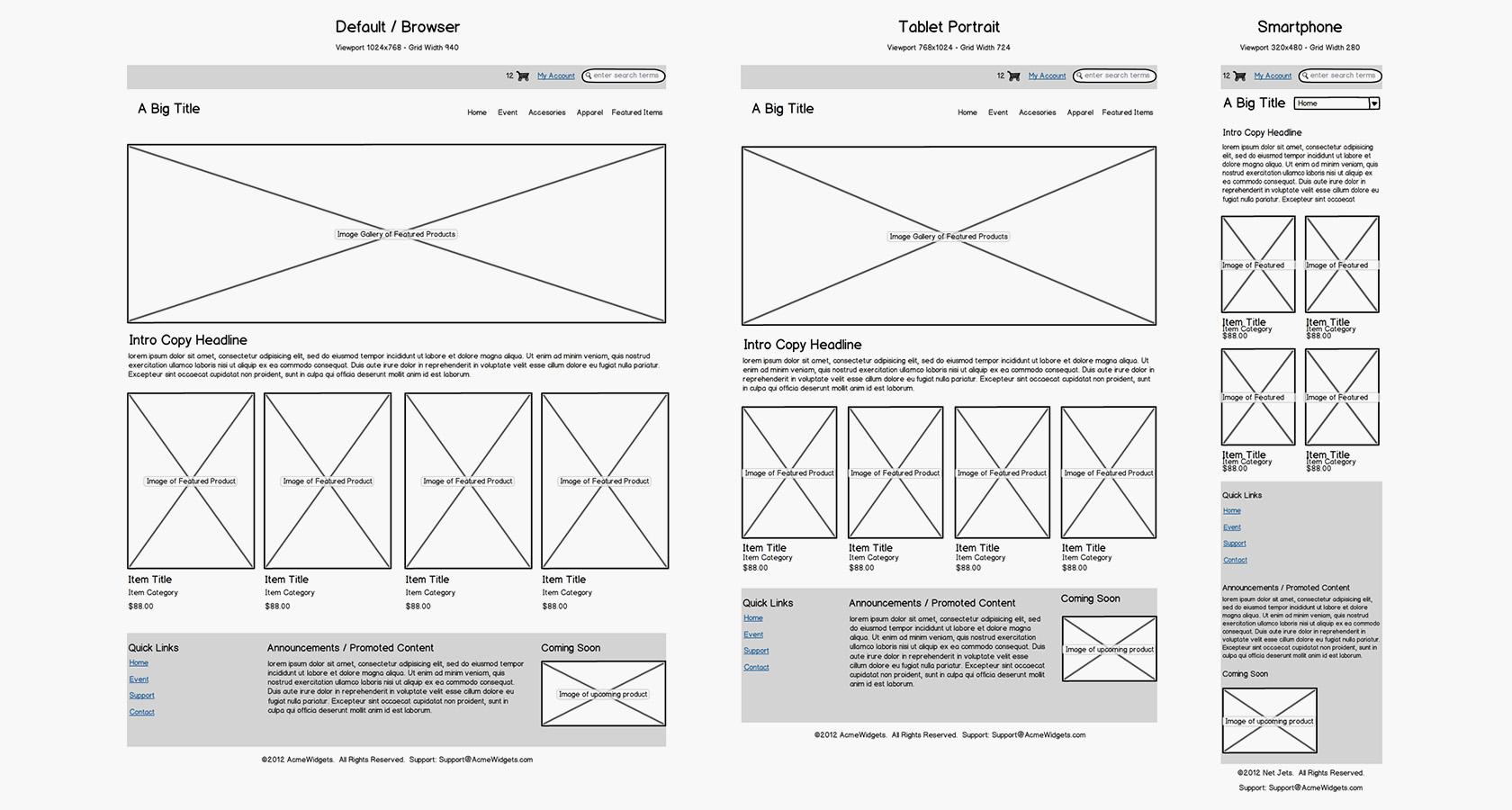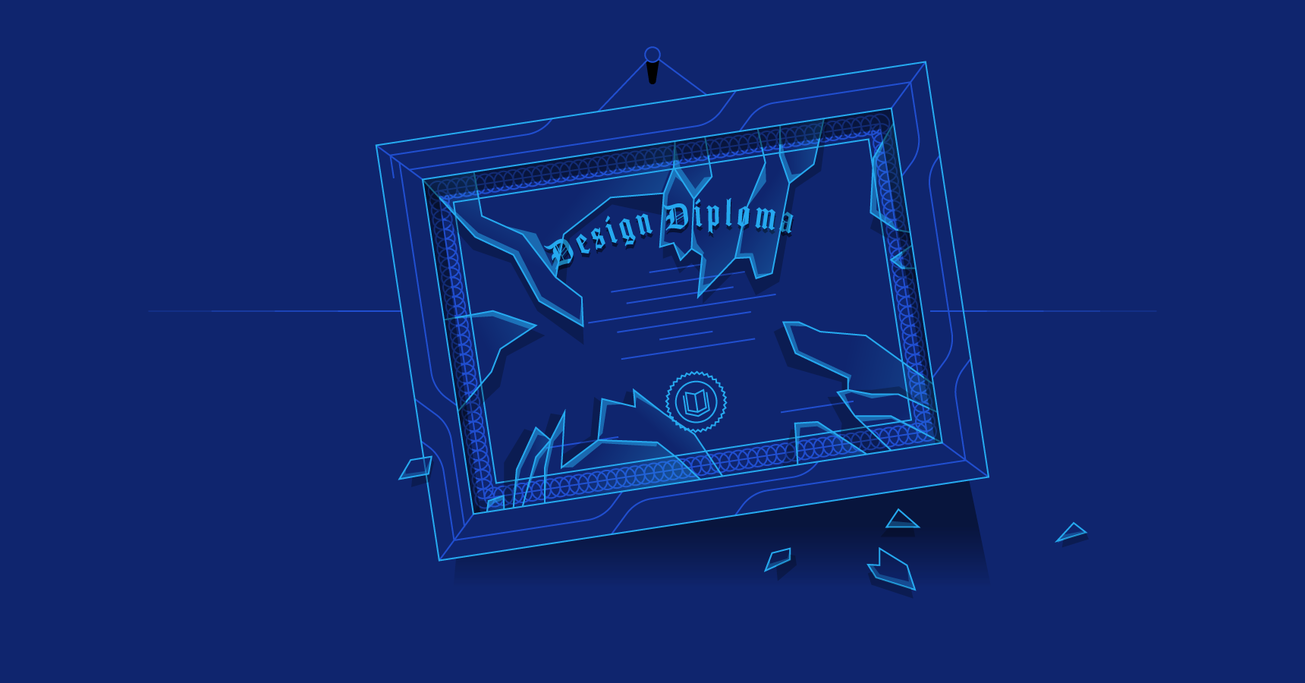Why You Don’t Need Design Education
For decades, a design diploma was the golden ticket to career opportunity. As this path now faces scrutiny, we examine the issues plaguing design institutions and offer radical solutions for change.
For decades, a design diploma was the golden ticket to career opportunity. As this path now faces scrutiny, we examine the issues plaguing design institutions and offer radical solutions for change.
Micah helps businesses craft meaningful engagement through branding, illustration, and design.
Expertise
Design is a process, but it’s not predictable. Breakthroughs arrive suddenly, and innovation occurs without warning. Designers face obstacles and employ strategies they hope will bring solutions. It’s a tug of war between trial and triumph.
Perhaps then the most useful skill a designer can acquire, especially early on, is the ability to grasp new subjects and apply that knowledge to a wide variety of design problems. More than technical proficiency or a polished portfolio, learning to learn has long been one of the great outcomes of design education.
For centuries, aspiring artists and designers have gathered to wrestle with technique and theory. Educational environments have varied, but the format has remained consistent: Industry tested instructors challenge students with exercises that unveil the why’s and how’s of their chosen discipline.
From the Renaissance onward, this played out through the arrangement between master and apprentice, but 100 years ago institutions like the Bauhaus and The New School ignited a golden era of design schools—academies of higher learning responsible for many of our major stylistic movements and problem-solving methodologies. These schools also produced a generation of design celebrities whose work profoundly influenced our built environment and popular culture.

Today, the world of design is changing at a pace unparalleled in prior human history, but the noble roots of design education have hollowed, encasing a severely compromised structure within a veneer of pomp and tradition. The relevance of a design diploma is disappearing, and unless design schools undergo radical transformation, they’ll fade into antiquity as a new educational paradigm emerges.
To be clear, the model in question is the traditional, four-year university path that leads to a bachelor’s degree—as there now exists a growing number of 10-12 week “academies” that promise to prepare students for design jobs (often in UX) at a fraction of the cost of a four-year degree. The effectiveness of these “academies” is sharply contested, but we’ll save our investigation for a later date.
*Note: Not everyone holds the position that design schools are in peril. In a follow-up article, designer Jordan DeVos will offer a rebuttal in defense of design institutions and educators.
The Cost of Tuition Crushes Aspiring Designers
In the United States, design school tuition at a four-year university is astronomically high. Add on the ensuing years of student loan repayment, and what do you get?
A generation of promising young designers struggling for professional stability while coping with creativity sucking financial stressors.
Overly sensationalized? Consider…
- On average, yearly tuition for undergraduates attending the top 25 design schools in the USA is $30,660.
- Every school in the top 25 is a 4-year school, meaning the average 4-year tuition of these institutions is $122,640.
- These numbers don’t include housing, food, or supplies, which can add anywhere between $10-20,000 of cost annually.
- Two years after graduation, the median yearly income for graduates from the top 25 design schools is $39,748.

These numbers aren’t great, but eventually, most designers earn six digits, and the educational investment pays off, right? Well…
- The yearly mean wage for America’s 600,000 Art and Design Workers is $54,000.
- For Graphic Designers, the figure is $53,300.
- For Commercial and Industrial Designers, it’s $70,600.
There’s a nuance to numbers, and averages don’t speak to all stories. Still, the tuition decisions facing design hopefuls are distressing. When the training’s higher than the earning, something’s off.
A Radical Solution: Cut All Non-design Courses
In an informational age, we remain strangely enamored with a Medieval learning model conceived to counteract the exorbitant price of books in the 14th century. So it is that we have design students required to purchase as many as 50-60 liberal arts credit hours for courses completely unrelated to their career path. At $400-1,800 per credit hour (plus living expenses and supplies), it seems someone’s being taken for a ride.
What to do?
Adopt an accelerated, 48-week program, and cut every class that isn’t directly related to design theory, methodology, or application.
Anthropology of Microeconomics? Slice it.
Quantitative Topics in Psychology? Dice it.
Fundamentals of Horticulture? Get outta here!
There’s no reason for student designers to spend four years acquiring debt on unnecessary classes when the bulk of their training can be accomplished in one year of rigorous study.

Design Education Graduates Aren’t Ready for Real-world Design Jobs
Whether it’s at a small agency or a large corporation, the high-level conceptual initiatives of important design projects are most often entrusted to senior staff. In other words, it takes time to be the person dishing out big ideas.
Entry level designers spend a lot of hours on routine tasks like setting type, aligning pixels, and organizing file libraries. That’s not to say new designers don’t engage in discovery and concept ideation, but by and large, their roles require technical command.
Many rookie designers leave school unprepared for the pace, output, and quality expectations of real-world design teams. Design schools provide ample space for students (aka paying customers) to explore areas of interest and experiment with avant garde ideas, but what does this accomplish?
Two things: It inflates students’ creative vanity and prepares them for the unpaid passion projects that will occupy their evenings and weekends after entering the workforce.
Unfortunately, it does not ready new designers to deliver high-quality results when deadlines are approaching, nor does it enable collaboration within multidisciplinary teams—a must for designers of digital brands and products.
A Radical Solution: Emulate the Journeyman Model
Student-initiated curriculum? Great marketing, but does it cultivate the speed, organization, and endurance graduates will need in their first design jobs? Will it brace them for that frenetic first week when they’re asked to assemble 500 banner ads or review 200 wireframes before day’s end?
The only way to prepare for that kind of grind is firsthand experience, which is why design schools ought to emulate the journeyman model utilized by the building trades.
Obviously, we’re talking very different fields, but the hands-on training received by trades apprentices has been proven to:
- Create a steady supply of highly skilled workers;
- Increase employee retention;
- And ensure that tradespeople are able to begin their careers with minimal or no educational debt.

How can design schools incorporate a similar approach? Here are seven practical steps:
- Before students ever step foot on campus, schools should clearly define the design environment their program mirrors. Whether that be a high-tempo agency, an in-house design department, or a remote freelancing setup, students need to be aware of the post-graduation setting they’ll be best equipped to handle.
- Ditch self-directed learning paths and sprawling, semester-long projects. Design is deadline driven, and allowing students to meander through their own interests creates poor time management habits.
- Kick off new mini-projects every week addressing a specific facet of the design process. Each project could cover a different area of focus like user research or visual design, and all mini-projects could fit within a larger, team-oriented effort (i.e. designing the brand, UX, and UI of a digital product). The goal is to acclimate students to the pace and rhythm of a designer’s work week.
- Rotate students through clearly defined and interdependent design roles. At present, it’s too easy for students to work in isolation on projects that cater only to their strengths.
- Change the role of a professor from “educational facilitator” to that of a creative director. Designers in training don’t need more freedom of choice, they need to learn to work the creative soil of narrow constraints handed down by someone with more experience and authority than them.
- Bring in experienced, senior-level professionals to simultaneously provide mentorship and work alongside students. Advice is helpful, but students will also benefit by collaborating with veteran designers throughout the problem solving process.
- Measure daily progress, and address roadblocks, failures, and wins. This is a vital component of thriving design teams. Fast-paced projects introduce all kinds of obstacles and achievements, and a daily debrief is a great way for students to see what they’ve learned, where they’ve grown, and how they can improve.
Soft Skills Are Completely Ignored in Design Education
Design is a deeply human endeavor. As such, one of the primary contributors to a designer’s career success is mastering the art of communication. To navigate peer and client relationships effectively, designers need soft skills like:
- Role Flexibility - The ability to wear many hats and learn unfamiliar tasks
- Listening - A willingness to hear and understand others’ thoughts
- Collaboration - Sharing skills and ideas with others, and valuing theirs in return
- Evaluating Criticism - Sorting through feedback and deciding what’s actionable
- Task Prioritization - Knowing when to do what, and the amount of time it takes
- Persuasion - Helping others see and share in a vision
In a professional design environment, soft skills help designers understand the problems and people they’re working with. Regrettably, many entry level designers struggle to communicate their ideas and receive critique from colleagues and clients.
A lack of soft skills turns feedback into fighting words, makes problem solving personal, and halts meaningful progress through the design process.
This isn’t a character issue, and it’s not simply a matter of maturity. It’s a training failure. Too often, coursework is insufficiently challenged in peer critiques, and students are coddled by the false affirmation of passing grades.

A Radical Solution: Perform Real Projects for Real People
In one way, soft skills are like all skills, they aren’t innate in everyone, but they can be developed with practice.
However, unlike hard skills, soft skills can’t be practiced in controlled environments. The interpersonal nature of design is wildly unpredictable. People, places, and problems are always in flux.
The only way to address this is to turn theoretical, design school projects into real projects for real people. How might this work?
Design professors, with the help of students, would be required to secure paid projects (at a reduced rate) by tapping into alumni networks, the local business community, and other university departments. To incentivize staff and students in a real-world way, professors would earn monetary bonuses for projects landed and students would be paid from the earnings of projects they take part in.
The benefits of this plan are twofold:
- Students have the opportunity to identify problems, listen to feedback, and map out course corrections. They’re also able to present work, participate in critiques, and iterate new solutions—all under the guidance of a professor who can point out areas where they need to improve.
- Students get exposure to paying clients and the diverse challenges they impose on the design process. Selling design and managing financially invested clients will grant students many occasions to learn the soft skills that will be so vital to their career success.
Recapping A “Radical” Model
For design schools stuck in a rut of ritualistic methodology, we’ve outlined three solutions meant to radically alter the status quo.
- Cut all non-design courses and adopt an accelerated path to graduation (somewhere between 48-72 weeks).
- Emulate the journeyman model, and dramatically increase the number and frequency of design projects.
- Build soft skills by requiring that students and professors engage in real projects with real clients.
Such a model gives aspiring designers access to rigorous yet affordable training, prepares them to thrive in the demanding realities of junior design roles, and equips them with career accelerating communication abilities.
Is that really so radical?
Education Isn’t the Issue
Here’s the truth. To be a designer requires a ton of education. The learning never stops. No amount of knowledge is enough. There’s always more to discover because we make things with the core intent of improving people’s lives, something we can never achieve without an ongoing devotion to learning.

Don’t misunderstand. Education isn’t in question. Learning isn’t on trial. To be a designer requires a robust curiosity that explores and investigates the diverse ways people inhabit and experience the world around us.
However, it’s time to rethink a model that forces students to spend hundreds of thousands of dollars to obtain a certificate of authenticity before stumbling into a highly competitive industry where they’ll initially be underpaid, underprepared, and most certainly underappreciated.
The four-year design school must change, or it will be replaced by an approach that more capably addresses the resources, abilities, and professional development of aspiring designers.
Further Reading on the Toptal Blog:
Understanding the basics
What education do you need to become a graphic designer?
When it comes to graphic designer education requirements, there is no universal standard for obtaining a design job. Many graphic designers attend four-year universities, some are self-taught, and others transition into the field from different design disciplines.
What do you need to know to be a UX designer?
UX education must be comprehensive, but one of the main things UX designers need to know how to do is perform and interpret user research. It’s also important to weigh design fundamentals vs. tools because design tools change so often. Ultimately, the right education makes you a more valuable designer.
What jobs involve design and technology?
As digital products revolutionize the world of work, countless jobs have become dependent on design and technology. Further highlighting the importance of a robust design education, jobs for designers can be found in a diverse array of fields like healthcare, fashion, agriculture, and entertainment.
Micah Bowers
Vancouver, WA, United States
Member since January 3, 2016
About the author
Micah helps businesses craft meaningful engagement through branding, illustration, and design.

